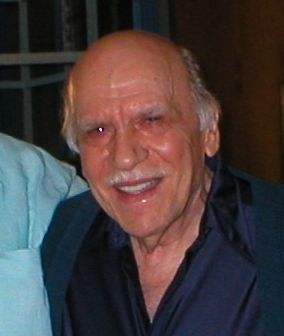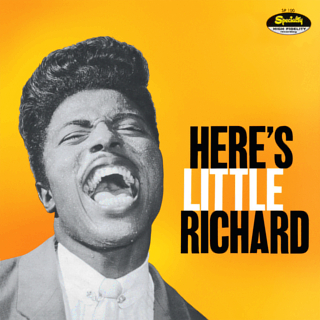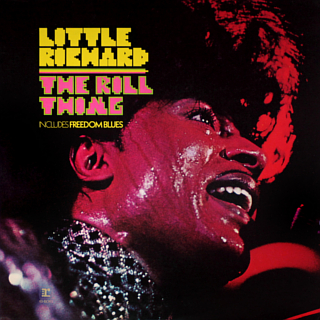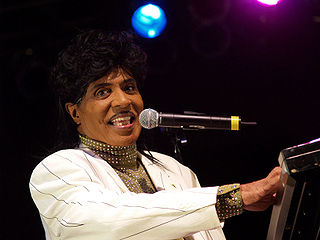
Richard Wayne Penniman, known professionally as Little Richard, was an American singer, pianist, and songwriter. He was an influential figure in popular music and culture for seven decades. Described as the "Architect of Rock and Roll", Richard's most celebrated work dates from the mid-1950s, when his charismatic showmanship and dynamic music, characterized by frenetic piano playing, pounding back beat and powerful raspy vocals, laid the foundation for rock and roll. Richard's innovative emotive vocalizations and uptempo rhythmic music played a key role in the formation of other popular music genres, including soul and funk. He influenced singers and musicians across musical genres from rock to hip hop; his music helped shape rhythm and blues for generations.

Larry Williams was an American rhythm and blues and rock and roll singer, songwriter, producer, and pianist from New Orleans, Louisiana. Williams is best known for writing and recording some rock and roll classics from 1957 to 1959 for Specialty Records, including "Bony Moronie", "Short Fat Fannie", "Slow Down", "Dizzy, Miss Lizzy" (1958), "Bad Boy" and "She Said Yeah" (1959). John Lennon was a fan, and The Beatles and several other British Invasion groups recorded several of his songs.

John S. Marascalco was an American songwriter most noted for the songs he wrote for Little Richard. He was born in Grenada, Mississippi and died in Los Angeles, California.

Here's Little Richard is the debut album by American musician Little Richard, released on March 4, 1957. Promoted as "six of Little Richard's hits and six brand new songs of hit calibre", the album compiles many of the A-sides and B-sides from Richard's hit singles including the Billboard top 40 entries "Tutti Frutti", "Long Tall Sally", "Slippin' and Slidin'", "Rip It Up" and "Jenny, Jenny" and the top 10 Rhythm and Blues Best-Sellers hits "Ready Teddy", "She's Got It" and "Miss Ann".

The song "Hey-Hey-Hey-Hey", also known as "Hey-Hey-Hey-Hey! ", was written by Little Richard and recorded on May 9, 1956 at J&M Studio, New Orleans, Louisiana,.

Tutti Frutti is a song written by Little Richard and Dorothy LaBostrie, recorded in 1955, which was his first major hit. With its energetic refrain, often transcribed as "A-wop-bop-a-loo-mop-a-lop-bam-boom!", and its hard-driving sound and wild lyrics, it became not only a model for many future Little Richard songs, but also for rock and roll itself. The song introduced several of rock music's most characteristic musical features, including its loud volume, powerful vocal style, and distinctive beat and rhythm.

Eskew Reeder, Jr., usually known by the stage name Esquerita, and occasionally as S.Q. Reeder or The Magnificent Malochi, was an American R&B singer, songwriter and pianist, known for his frenetic performances. He has been credited with influencing rock and roll pioneer Little Richard.
Arthur Newton Rupe was an American music executive and record producer. He founded Specialty Records, known for its rhythm and blues, blues, gospel and early rock and roll music recordings, in Los Angeles in 1946.
Robert Alexander "Bumps" Blackwell was an American bandleader, songwriter, arranger, and record producer, best known for his work overseeing the early hits of Little Richard, as well as grooming Ray Charles, Quincy Jones, Ernestine Anderson, Lloyd Price, Sam Cooke, Herb Alpert, Larry Williams, and Sly and the Family Stone at the start of their music careers.

"Kansas City" is a rhythm and blues song written by Jerry Leiber and Mike Stoller in 1952. First recorded by Little Willie Littlefield the same year, the song later became a chart-topping hit when it was recorded by Wilbert Harrison in 1959. "Kansas City" is one of Leiber and Stoller's "most recorded tunes, with more than three hundred versions", with several appearing in the R&B and pop record charts.

"Lucille" is a 1957 rock and roll song originally recorded by American musician Little Richard. Released on Specialty Records in February 1957, the single reached number 1 on the Billboard R&B chart, 21 on the US pop chart, and number 10 on the UK chart. It was composed by Albert Collins and Little Richard. First pressings of Specialty 78rpm credit Collins as the sole writer. Little Richard bought half of the song's rights while Collins was in Louisiana State Penitentiary.

Together: Edgar Winter and Johnny Winter Live is a 1976 album by brothers Johnny Winter and Edgar Winter. Released just three months after Johnny Winter's Captured Live!, it is composed entirely of rock and roll and soul standards. This album is a chance to hear The Edgar Winter Group playing with Johnny Winter's band together on a same stage.

Little Richard's Greatest Hits - Recorded Live! is the second and last album by Little Richard for the Okeh label. A live album, it was recorded in the CBS Studios at Hollywood.

The Rill Thing is Little Richard's first album for Reprise Records, released in August 1970. It was considered a comeback album for Richard, following a three-year hiatus on new albums and an acclaimed performance at Atlantic City Pop Festival. The album utilizes a soul-influenced sound and contains Little Richard's biggest post-Specialty single in "Freedom Blues", which broke the Billboard top 50. The follow-up single, "Greenwood, Mississippi" made the top 100 and number 56 on Cashbox Black Singles. Despite the success of the singles, the album failed to chart.

Little Richard's Greatest Hits is an album of Little Richard songs re-recorded in 1964 and first released in the US by Vee-Jay Records in January 1965. It features updated versions of twelve of his best-known songs originally recorded in the 1950s for Specialty Records. Some of these re-recordings use different musical arrangements, including unusual syncopation, tambourine and jazz horns.

Little Richard Live! 20 Super Hits is a recording of a live-in-studio performance by Little Richard. Recorded at the Jack Clement Studio in Nashville before an audience, the album featured remakes of twenty of his Specialty Records tracks. Counting the live takes on this album, this was the second time that Richard had rerecorded his 1950s hits in studio. These August 1976 sessions and an early 1990s session with Japanese guitarist Masayoshi Takanakka are the last times that Penniman would re-record his 1950s hits for an album before his death in May 2020. Alternate takes from these sessions are found on a full stereo "Audiophile" album from 1980.

This page is a discography for American musician Little Richard (1932–2020). Described as "the architect of rock and roll", Little Richard was a pioneering singer-songwriter whose career also encompassed rhythm and blues, soul, and gospel. He began his recording career in 1951, signing to RCA Victor, releasing his first singles, and his first album in 1957, although he released his last album in 1992, he continued to tour into the 21st century. He attained international success after signing with Specialty Records in 1955.
"Keep A-Knockin' " is a popular song that has been recorded by a variety of musicians over the years. The lyrics concern a lover at the door who will not be admitted; some versions because someone else is already there, but in most others because the knocking lover has behaved badly.

Little Richard is the second album by American musician Little Richard, released in July 1958, ten months after Richard announced a retirement from rock and roll to pursue a life in the ministry. Like his first album, it largely contains previously released A-sides and B-sides including several which reached Billboard's Rhythm & Blues and Hot 100 charts. Nine of its twelve tracks charted in the US including Richard's fourth million-seller "Lucille", the rock and roll standard "Good Golly, Miss Molly" and "The Girl Can't Help It", the title song from the motion picture of the same name. Among the previously unreleased tracks are two Tin Pan Alley songs recorded in Richard's frantic style.

Shake It All About is a children's music album by Little Richard, released on Walt Disney Records in 1992. The album followed the success of Richard's rock and roll-based cover of "The Itsy Bitsy Spider", which convinced Disney to allow Richard to record an album of children's songs in his trademark rock and roll style.

















